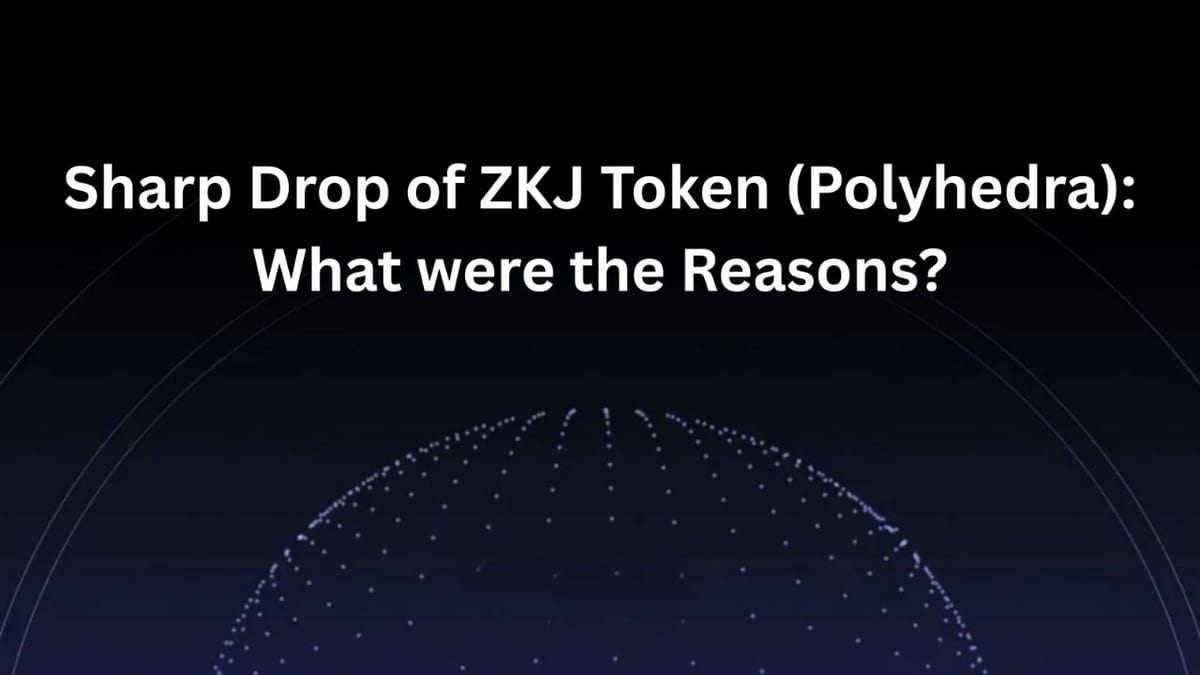Sharp Drop of ZKJ Token (Polyhedra): What Were the Reasons?

The cryptocurrency market is no stranger to volatility, with tokens rising and falling sharply based on investor sentiment, market dynamics, and underlying project fundamentals. One of the recent notable cases is the precipitous decline of the ZKJ token, native to Polyhedra Network, which plummeted by over 80% within a short span in mid-2025. This article offers an in-depth analysis of the reasons behind this sharp drop, examining the launch hype that built expectations, the dynamics involving venture capital and token listings that led to significant selling pressure, and, importantly, the investment lessons arising from such short-term zero-knowledge (ZK) projects.
1. Launch Hype: How the Buzz Around ZKJ Was Built
The initial launch period of any token can dramatically influence its trajectory in the market. For ZKJ, the token underpinning the Polyhedra Network, the hype phase was marked by strategic marketing and intense community engagement that captured the growing excitement around zero-knowledge cryptography.
1.1 Background of Polyhedra Network and ZKJ Token
Polyhedra Network emerged as a newcomer in the blockchain ecosystem aiming to leverage zero-knowledge proofs to enhance scalability and privacy key hurdles in decentralized networks. The ZKJ token was positioned as the utility and governance token for Polyhedra’s ecosystem, with wide-ranging use cases including staking, network security, and incentives for validators and developers.
1.2 Marketing and Hype Strategies
Before the token went public, Polyhedra executed a comprehensive campaign combining:
- Influencer Partnerships: Collaborations with well-known crypto influencers and analysts helped amplify visibility, creating social proof among potential investors.
- Social Media Campaigns: Active engagement on Twitter, Telegram, and Discord via AMAs (Ask Me Anything sessions), contest giveaways, and regular updates built a vibrant community.
- Early Access and Private Sales: Limited private sales and seed rounds attracted venture capital and private investors, setting up initial token allocations that were later to be unlocked.
- Educational Content: Publishing whitepapers, technical blog posts, and explainer videos on zero-knowledge technology to convince the audience of the project’s technological merit.
1.3 Impact on Token Demand and Price
The excitement around zero-knowledge proofs combined with effective social engagement generated frenzied interest. Such hype often drives speculative buying, sharply increasing demand and thus price ahead of or immediately after launch. Early adopters and retail investors sought quick gains, pushing ZKJ token’s price to peak levels far above initial private sale valuations.
However, hype-driven price rises can be precarious, as they frequently overinflate valuations relative to fundamental project progress, creating bubble-like conditions vulnerable to rapid deflation.
1.4 Comparisons with Other Crypto Token Launches
This pattern resembles other high-profile token launches in the crypto space, such as the infamous Rug Pulls and liquidity crises seen with certain DeFi tokens and NFTs, where hype outpaced sustainable demand. The initial buzz creates FOMO (Fear of Missing Out) and draws in inexperienced investors who might underestimate underlying risks.
The ZKJ token launch’s hype was a textbook example of well-structured marketing combined with technological promise driving rapid price elevation — but also setting the stage for volatility when early investors moved to realize profits.
2. VC and Listing Dynamics: Who Dumped Tokens on the Market
After a successful token launch and listing, the price is not solely determined by organic demand but heavily influenced by how venture capital (VC) investors and insiders participate in selling, especially in projects like Polyhedra where large private allocations are common.
2.1 Role of Early Investors and Venture Capitalists
Venture capitalists and seed investors typically acquire tokens at significantly discounted rates during private rounds before public launch. These low-cost holdings carry lucrative potential returns if the token appreciates. However, these investors often face increasing pressure to cash out following public listings to recoup capital and generate profits for their funds.
In the case of ZKJ, evidence from on-chain data and exchange inflows indicates massive token movement from VC and early investor wallets into centralized exchanges. This created a flood of supply at market prices much higher than their acquisition costs, aggressively driving down the price.
2.2 Mechanics of Token Listings and Liquidity
Polyhedra’s token was listed on multiple exchanges, including centralized exchanges (CEXs) such as Binance and KOGE. While listings naturally expand access to liquidity and investor base, they also expose early allocations to potential selling pressure beyond the control of the project.
Key factors observed include:
- Unlocking Schedules and Vesting: Token vesting timelines meant large tranches of ZKJ tokens became transferable around the same period, coinciding with the launch and immediately after.
- Liquidity Attacks: Polyhedra publicly reported that coordinated timing of sell orders and strategic on-chain trades created liquidity cascades, amplifying sell pressure.
- Exchange Deposits: Large deposits of ZKJ tokens by VC wallets to CEXs provided sellers convenient channels to liquidate their positions swiftly.
2.3 Data Insights: On-Chain Activity and Price Impact
Several analytics platforms and market watchers tracked on-chain activity, revealing that a significant portion of the ZKJ token supply was moved to exchanges shortly after the launch. This influx of tokens coincided with a rapid decline in price, as the market struggled to absorb the sudden increase in supply.
The data indicated that:
- Sell Volumes: The sell volumes from early investors were substantial, leading to a cascading effect where the price dropped sharply as more tokens were sold.
- Market Sentiment: The rapid price decline triggered panic among retail investors, leading to further sell-offs and exacerbating the downward trend.
3. Takeaways for Investors: Risks of Short-Term ZK Projects
The sharp decline of the ZKJ token serves as a cautionary tale for investors in the cryptocurrency space, particularly those interested in short-term ZK projects. The volatility associated with newly launched tokens can pose significant risks, including:
1. Market Manipulation Risks
The potential for liquidity attacks and coordinated sell-offs by early investors can lead to sudden price drops, as seen with ZKJ. Investors should be aware that the market can be manipulated by those with significant holdings, leading to unpredictable price movements.
2. Lack of Fundamental Support
Many short-term projects may lack the robust fundamentals necessary to sustain long-term growth, making them susceptible to market fluctuations. Investors should conduct thorough research into the project's technology, team, and roadmap before investing.
3. Regulatory Risks
The evolving regulatory landscape surrounding cryptocurrencies can impact token valuations and investor confidence. Projects that do not comply with regulations may face legal challenges, leading to further price declines.
4. Emotional Trading Behavior
The hype surrounding new projects can lead to emotional decision-making, resulting in panic selling during downturns. Investors should remain disciplined and avoid making impulsive decisions based on market sentiment.
3.1 Recommendations for Risk Management
Investors should consider the following strategies to mitigate risks associated with short-term ZK projects:
- Diversification: Spread investments across multiple projects to reduce exposure to any single token's volatility.
- Due Diligence: Conduct thorough research on the project's fundamentals, team, and technology before investing.
- Set Realistic Expectations: Understand that high returns often come with high risks, and be prepared for potential losses.
- Stay Informed: Keep up with market trends, regulatory developments, and project updates to make informed investment decisions.
Conclusion
The sharp drop in the ZKJ token's value underscores the complexities and inherent risks of investing in emerging blockchain technologies. While initial excitement can drive prices upward, subsequent market dynamics, including VC sell-offs and liquidity challenges, can lead to substantial losses. Investors must conduct thorough research and remain cautious of the volatility associated with short-term projects.
The ZKJ token's decline serves as a critical reminder of the risks associated with investing in the cryptocurrency space, particularly in projects that rely heavily on hype and speculation. As the market continues to evolve, it is essential for investors to remain vigilant and informed to navigate the challenges and opportunities that lie ahead.
References and Further Reading
For those looking to deepen their understanding of the factors influencing the ZKJ token's decline, the following resources provide valuable insights:



Comments ()